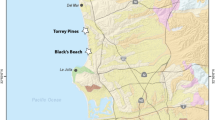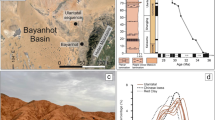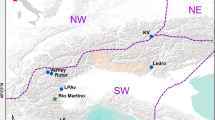Abstract
Continental-scale ice sheets have covered Antarctica since an interval of global cooling near the Eocene–Oligocene boundary around 33.9 million years ago (Ma). However, the sequence of events that led to the emergence of the persistent ice sheet in modern East Antarctica remains disputed. The transition to permanent polar aridity in high elevations of East Antarctica is critical to our understanding of the threshold response of glacial systems in Antarctica to changes in surface temperature at lower elevations. Here we constrain the onset of the polar aridity—which was probably necessary for regional ice-sheet stability—by assessing meteoric beryllium-10 profiles in mid-Miocene and late Quaternary soils at three sites situated 1,200–1,800 metres above sea level in the McMurdo Dry Valleys. Interpreting these profiles as indicators of water infiltration, we find that meteoric beryllium-10 entered mid-Miocene soils as late as the late Miocene. Reconstructions based on palaeo-active-layer thickness and known thresholds of meteoric beryllium-10 mobility suggest late Miocene summer temperatures of 7–10 °C with annual precipitation >10 mm. Therefore, the high elevations have probably been under a hyper-arid polar climate since the late Miocene (~6 Ma) and not the middle Miocene (13.8–12.5 Ma) as indicated by some previous reconstructions. Together, our findings indicate that high elevations of the McMurdo Dry Valleys probably experienced warm and wet climatic intervals from ~14.0 to 6.0 Ma, which reconciles observations of coastal warmth and reduced ice in the Ross Embayment. This finding also suggests that the McMurdo Dry Valleys may be more susceptible to climate change than anticipated.
This is a preview of subscription content, access via your institution
Access options
Access Nature and 54 other Nature Portfolio journals
Get Nature+, our best-value online-access subscription
$29.99 / 30 days
cancel any time
Subscribe to this journal
Receive 12 print issues and online access
$259.00 per year
only $21.58 per issue
Buy this article
- Purchase on Springer Link
- Instant access to full article PDF
Prices may be subject to local taxes which are calculated during checkout




Similar content being viewed by others
Code availability
The latest version of the PERICLIMv1.0 model is available as an R package from https://github.com/tomasuxa/PERICLIMv1.0 (last accessed 30 January 2022).
References
Coxall, H. K., Wilson, P. A., Pälike, H., Lear, C. H. & Backman, J. Rapid stepwise onset of Antarctic glaciation and deeper calcite compensation in the Pacific Ocean. Nature 433, 53–57 (2005).
Zachos, J. C., Dickens, G. R. & Zeebe, R. E. An early Cenozoic perspective on greenhouse warming and carbon-cycle dynamics. Nature 451, 279–283 (2008).
Warny, S. et al. Palynomorphs from a sediment core reveal a sudden remarkably warm Antarctica during the middle Miocene. Geology 37, 955–958 (2009).
Miller, K. G. et al. Cenozoic sea-level and cryospheric evolution from deep-sea geochemical and continental margin records. Sci. Adv. 6, aaz1346 (2020).
Spector, P. & Balco, G. Exposure-age data from across Antarctica reveal mid-Miocene establishment of polar desert climate. Geology 49, 91–95 (2021).
McKay, R. et al. The stratigraphic signature of the late Cenozoic Antarctic Ice Sheets in the Ross Embayment. Geol. Soc. Am. Bull. 121, 1537–1561 (2009).
Marchant, D. & Head, J. W. III Antarctic Dry Valleys: microclimate zonation, variable geomorphic processes, and implications for assessing climate change on Mars. Icarus 192, 187–222 (2007).
Denton, G. H., Sugden, D. E., Marchant, D., Hall, B. L. & Wilch, T. I. East Antarctic Ice Sheet sensitivity to Pliocene climatic change from a Dry Valleys perspective. Geogr. Ann. A 75, 155–204 (1993).
Sugden, D. E. et al. Preservation of Miocene glacier ice in East Antarctica. Nature 376, 412–414 (1995).
Summerfield, M. et al. Long-term rates of denudation in the Dry Valleys, Transantarctic Mountains, southern Victoria Land, Antarctica based on in-situ-produced cosmogenic 21Ne. Geomorphology 27, 113–129 (1999).
Valletta, R. D., Willenbring, J. K., Lewis, A. R., Ashworth, A. C. & Caffee, M. Extreme decay of meteoric Beryllium-10 as a proxy for persistent aridity. Sci. Rep. 5, 17813 (2015).
Hindmarsh, R., Van der Wateren, F. & Verbers, A. L. Sublimation of ice through sediment in Beacon Valley, Antarctica. Geogr. Ann. A 80, 209–219 (1998).
Dickinson, W. W. & Rosen, M. R. Antarctic permafrost: an analogue for water and diagenetic minerals on Mars. Geology 31, 199–202 (2003).
Lacelle, D. et al. Excess ground ice of condensation–diffusion origin in University Valley, Dry Valleys of Antarctica: evidence from isotope geochemistry and numerical modeling. Geochim. Cosmochim. Acta 120, 280–297 (2013).
Verret, M. et al. Cryostratigraphy of mid-Miocene permafrost at Friis Hills, McMurdo Dry Valleys of Antarctica. Antarct. Sci. 33, 174–188 (2020).
Schiller, M., Dickinson, W., Ditchburn, R., Graham, I. & Zondervan, A. Atmospheric 10Be in an Antarctic soil: implications for climate change. J. Geophys. Res. Earth Surf. 114, F01033 (2009).
Dickinson, W. W., Schiller, M., Ditchburn, B. G., Graham, I. J. & Zondervan, A. Meteoric Be-10 from Sirius Group suggests high elevation McMurdo Dry Valleys permanently frozen since 6 Ma. Earth Planet. Sci. Lett. 355, 13–19 (2012).
McHargue, L. & Damon, P. The global beryllium-10 cycle. Rev. Geophys. 29, 141–158 (1991).
Willenbring, J. K. & von Blanckenburg, F. Meteoric cosmogenic beryllium-10 adsorbed to river sediment and soil: applications for Earth-surface dynamics. Earth Sci. Rev. 98, 105–122 (2010).
Fountain, A., Nylen, T. H., Monaghan, A., Basagic, H. J. & Bromwich, D. Snow in the McMurdo Dry Valleys, Antarctica. Int. J. Climatol. 30, 633–642 (2010).
Lewis, A. R. & Ashworth, A. C. An early to middle Miocene record of ice-sheet and landscape evolution from the Friis Hills, Antarctica. Geol. Soc. Am. Bull. 128, 719–738 (2015).
Chorley, H. et al. East Antarctic Ice Sheet variability during the middle Miocene Climate Transition captured in drill cores from the Friis Hills, Transantarctic Mountains. Geol. Soc. Am. Bull. 135, 1503–1529 (2022).
Goff, J. R., Jennings, I. W. & Dickinson, W. W. Depositional environment of Sirius Group sediments, Table Mountain, Dry Valleys area, Antarctica. Geogr. Ann. A 84, 11–24 (2002).
Marchant, D., Denton, G., Swisher, C. C. III & Potter, N. Jr Late Cenozoic Antarctic paleoclimate reconstructed from volcanic ashes in the Dry Valleys region of southern Victoria Land. Geol. Soc. Am. Bull. 108, 181–194 (1996).
Ivy-Ochs, S., Schlüchter, C., Kubik, P. W., Dittrich-Hannen, B. & Beer, J. Minimum 10Be exposure ages of early Pliocene for the Table Mountain plateau and the Sirius Group at Mount Fleming, Dry Valleys, Antarctica. Geology 23, 1007–1010 (1995).
Trinh-Le, C. A. Dry Sedimentation Processes in the High-Elevation McMurdo Dry Valleys, Antarctica: A Case Study in University Valley. MSc thesis, Victoria Univ. Wellington (2017).
Lacelle, D. et al. Solar radiation and air and ground temperature relations in the cold and hyper‐arid Quartermain Mountains, McMurdo Dry Valleys of Antarctica. Permafr. Periglac. Process. 27, 163–176 (2016).
Takahashi, Y., Minai, Y., Ambe, S., Makide, Y. & Ambe, F. Comparison of adsorption behavior of multiple inorganic ions on kaolinite and silica in the presence of humic acid using the multitracer technique. Geochim. Cosmochim. Acta 63, 815–836 (1999).
Campbell, I. & Claridge, G. Antarctica: Soils, Weathering Processes and Environment (Elsevier, 1987).
Fisher, D. A., Lacelle, D., Pollard, W. & Faucher, B. A model for stable isotopes of residual liquid water and ground ice in permafrost soils using arbitrary water chemistries and soil-specific empirical residual water functions. Permafr. Periglac. Process. 32, 248–260 (2020).
Shang, J., Flury, M., Chen, G. & Zhuang, J. Impact of flow rate, water content, and capillary forces on in situ colloid mobilization during infiltration in unsaturated sediments. Water Resour. Res. 44, W06411 (2008).
Wang, F. et al. Beryllium-10 concentrations in the hyper-arid soils in the Atacama Desert, Chile: implications for arid soil formation rates and El Niño driven changes in Pliocene precipitation. Geochim. Cosmochim. Acta 160, 227–242 (2015).
Pringle, D., Dickinson, W., Trodahl, H. & Pyne, A. Depth and seasonal variations in the thermal properties of Antarctic Dry Valley permafrost from temperature time series analysis. J. Geophys. Res. Solid Earth 108, 1–12 (2003).
Burn, C. R. Cryostratigraphy, paleogeography, and climate change during the early Holocene warm interval, western Arctic coast, Canada. Can. J. Earth Sci. 34, 912–925 (1997).
Adlam, L. S., Balks, M. R., Seybold, C. A. & Campbell, D. I. Temporal and spatial variation in active layer depth in the McMurdo Sound Region, Antarctica. Antarct. Sci. 22, 45–52 (2010).
Uxa, T., Křížek, M. & Hrbáček, F. PERICLIMv1.0: a model deriving palaeo-air temperatures from thaw depth in past permafrost regions. Geosci. Model Dev. 14, 1865–1884 (2021).
Lewis, A. et al. Mid-Miocene cooling and the extinction of tundra in continental Antarctica. Proc. Natl Acad. Sci. USA 105, 10676–10680 (2008).
Fountain, A. & Doran, P. McMurdo Dry Valleys Friis Hills Meteorological Station daily averages, version 5. Environmental Data Initiative https://doi.org/10.6073/pasta/9dda244e95ce8dfcdbd9b94d2289ef1d (2016).
Van Tatenhove, F. G. & Olesen, O. B. Ground temperature and related permafrost characteristics in West Greenland. Permafr. Periglac. Process. 5, 199–215 (1994).
Ohneiser, C. et al. Warm fjords and vegetated landscapes in early Pliocene East Antarctica. Earth Planet. Sci. Lett. 534, 116045 (2020).
Rees-Owen, R. L. et al. The last forests on Antarctica: reconstructing flora and temperature from the Neogene Sirius Group, Transantarctic Mountains. Org. Geochem. 118, 4–14 (2018).
Hambrey, M. J. & McKelvey, B. Major Neogene fluctuations of the East Antarctic Ice Sheet: stratigraphic evidence from the Lambert Glacier region. Geology 28, 887–890 (2000).
Gulick, S. P. et al. Initiation and long-term instability of the East Antarctic Ice Sheet. Nature 552, 225–229 (2017).
Herbert, T. D. et al. Late Miocene global cooling and the rise of modern ecosystems. Nat. Geosci. 9, 843–847 (2016).
Prebble, J. G. et al. Terrestrial climate evolution in the Southwest Pacific over the past 30 million years. Earth Planet. Sci. Lett. 459, 136–144 (2017).
Super, J. R. et al. Miocene evolution of North Atlantic sea surface temperature. Paleoceanogr. Paleoclimatol. 35, 1e2019PA003748 (2020).
Shakun, J. D. et al. Minimal East Antarctic Ice Sheet retreat onto land during the past eight million years. Nature 558, 284–287 (2018).
Schuster, M. et al. The age of the Sahara desert. Science 311, 821–821 (2006).
Howat, I. M., Porter, C., Smith, B. E., Noh, M.-J. & Morin, P. The reference elevation model of Antarctica. Cryosphere 13, 665–674 (2019).
Antarctic Imagery. Esri, Earthstar Geographics http://goto.arcgisonline.com/maps/Antarctic_Imagery (2020).
Cox, S. et al. The GeoMAP (v.2022-08) continent-wide detailed geological dataset of Antarctica. PANGAEA https://doi.org/10.1594/PANGAEA.951482 (2022).
Westerhold, T. et al. An astronomically dated record of Earth’s climate and its predictability over the last 66 million years. Science 369, 1383–1387 (2020).
Miller, K. et al. The Phanerozoic record of global sea-level change. Science 310, 1293–1298 (2005).
Bierman, P. R., Shakun, J. D., Corbett, L. B., Zimmerman, S. R. & Rood, D. H. A persistent and dynamic East Greenland Ice Sheet over the past 7.5 million years. Nature 540, 256–260 (2016).
Wittmann, H. et al. The dependence of meteoric 10Be concentrations on particle size in Amazon River bed sediment and the extraction of reactive 10Be/9Be ratios. Chem. Geol. 318, 126–138 (2012).
Tessier, A., Campbell, P. G. & Bisson, M. Sequential extraction procedure for the speciation of particulate trace metals. Anal. Chem. 51, 844–851 (1979).
Bourles, D., Klinkhammer, G., Campbell, A., Brown, E. & Edmond, J. Beryllium in marine pore waters: geochemical and geochronological implications. Nature 341, 731–733 (1989).
Guelke-Stelling, M. & von Blanckenburg, F. Fe isotope fractionation caused by translocation of iron during growth of bean and oat as models of strategy I and II plants. Plant Soil 352, 217–231 (2012).
Nishiizumi, K. et al. Absolute calibration of 10Be AMS standards. Nucl. Instrum. Methods Phys. Res. B 258, 403–413 (2007).
Graham, I. et al. Dating Antarctic soils using atmosphere-derived 10Be and nitrate. in Antarctica at the Close of a Millennium (eds Gamble, S. et al.) 429–436 (Royal Society of New Zealand, Wellington, 2002).
Schiller, M. Testing the Antiquity of McMurdo Dry Valley Soil Surfaces with Atmospheric 10Be. MSc thesis, Victoria Univ. Wellington (2007).
Graham, I., Ditchburn, R. & Whitehead, N. Be isotope analysis of a 0–500 ka loess–paleosol sequence from Rangitatau East, New Zealand. Quat. Int. 76, 29–42 (2001).
Ditchburn, R. G. & Graham, I. Preparation Procedures for the 10Be Analysis of Marine Deposits Report No. INIS 26 (Institute of Geological and Nuclear Sciences, 2002).
Zondervan, A., Poletti, M., Purcell, C. R. & Sparks, R. J. Accelerator and beamline upgrades at the AMS facility of GNS Science, New Zealand. Nucl. Instrum. Methods Phys. Res. B 259, 47–49 (2007).
Jull, A. T., Scott, E. M. & Bierman, P. The CRONUS-Earth inter-comparison for cosmogenic isotope analysis. Quat. Geochronol. 26, 3–10 (2015).
Obryk, M. K., Doran, P. T., Fountain, A. G., Myers, M. & McKay, C. P. Climate from the McMurdo Dry Valleys, Antarctica, 1986–2017: surface air temperature trends and redefined summer season. J. Geophys. Res. Atmos. 125, e2019JD032180 (2020).
Morgan, D. J., Putkonen, J., Balco, G. & Stone, J. Degradation of glacial deposits quantified with cosmogenic nuclides, Quartermain Mountains, Antarctica. Earth Surf. Process. Landf. 36, 217–228 (2011).
Field, C. V., Schmidt, G. A., Koch, D. & Salyk, C. Modeling production and climate‐related impacts on 10Be concentration in ice cores. J. Geophys. Res. Atmos. 111, D15107 (2006).
Kohn, M. J. Carbon isotope compositions of terrestrial C3 plants as indicators of (paleo) ecology and (paleo) climate. Proc. Natl Acad. Sci. USA 107, 19691–19695 (2010).
Ebert, K., Willenbring, J., Norton, K. P., Hall, A. & Hättestrand, C. Meteoric 10Be concentrations from saprolite and till in northern Sweden: implications for glacial erosion and age. Quat. Geochronol. 12, 11–22 (2012).
Jelinski, N. A. Problems of Physical Movement in Soil Genesis: Application of Meteoric Beryllium-10 as a Component of Multi-tracer Analysis. PhD thesis, Univ. Minnesota (2014).
Andersland, O. & Anderson, D. Geotechnical Engineering for Cold Regions (McGraw-Hill, 1978).
Cannone, N. & Guglielmin, M. Influence of vegetation on the ground thermal regime in continental Antarctica. Geoderma 151, 215–223 (2009).
Hrbáček, F., Nývlt, D. & Láska, K. Active layer thermal dynamics at two lithologically different sites on James Ross Island, Eastern Antarctic Peninsula. Catena 149, 592–602 (2017).
Streletskiy, D. A. et al. CALM north summary data table. The George Washington University https://www2.gwu.edu/~calm/data/north.htm (2022).
Acknowledgements
The Friis Hills Drilling Project (austral summer 2016–2017) was funded by the New Zealand Ministry of Business, Innovation and Employment through the Past Antarctic Science Programme (C05X1001) and the Antarctic Science Platform (ANTA1801) to R.L. and T.N. The sampling at University Valley was funded by a NASA-ASTEP grant. Fieldwork at Friis Hills and Table Mountain was made possible with the logistical support of Antarctica New Zealand. We thank A. Pyne, R. Pyne, H. Chorley and Webster Drilling for retrieving the cores at Friis Hills. A special thank you to N. Bertler for allowing us to use the GNS Ice Core Facility to store and sample the permafrost cores. Laboratory work was made possible with the help of the technical staff at the Cosmogenic Nuclide Laboratory at the Victoria University of Wellington (L. Ashworth) and the Laboratory of Ion Beam Physics at ETH, Zürich (P. Gautschi). AMS analysis was in part funded by an Antarctic Science International Ltd Bursary to M.V.
Author information
Authors and Affiliations
Contributions
M.V., W.D., K.N. and D.L. designed this project and contributed to data analysis/interpretation and writing the manuscript. C.T.-L. analysed the preliminary samples from Friis Hills (FA, C1 and C2) and University Valley. M.C. ran the 10Bemet samples, including AMS data reduction. R.L. and T.N. developed the Friis Hills Drilling Project. All authors edited the whole manuscript.
Corresponding author
Ethics declarations
Competing interests
The authors declare no competing interests.
Peer review
Peer review information
Nature Geoscience thanks Paul Bierman and the other, anonymous, reviewer(s) for their contribution to the peer review of this work. Primary Handling Editor: James Super, in collaboration with the Nature Geoscience team.
Additional information
Publisher’s note Springer Nature remains neutral with regard to jurisdictional claims in published maps and institutional affiliations.
Extended data
Extended Data Fig. 1 Photos of the location sites.
Photos of the location sites: a. Table Mountain core sites (TM01-1 and TM97) on desert pavement lying above Sirius Group sediments with Ferrar Glacier in the backdrop (photo credit: Warren Dickinson), b. ice table excavated at 30 cm depth at Friis Hills (photo credit: Richard Levy), c. drilling rig retrieving cores during the 2016-2017 Friis Hills Drilling Project (photo credit: Richard Levy) and, d. University Valley site with polygonal ground (photo credit: Denis Lacelle).
Extended Data Fig. 2 10Bemet and 10Bemet/9Be biplot.
Note: here, 9Be is measured independently on a MP-AES.
Extended Data Fig. 3 Duplicate samples at Table Mountain showing 10Bemet concentrations measured by aggressive and mild leaching methods.
Duplicate samples at Table Mountain showing 10Bemet concentrations measured by aggressive17 and mild leaching methods. Dataset in red offset using the duplicate function.
Extended Data Fig. 4 Comparison between mean annual air temperature and active layer measurements at different sites in the MDV and values predicted by the PERICLIMv1.0. model.
Comparison between mean annual air temperature and active layer measurements at different sites in the MDV35 and values predicted by the PERICLIMv1.0. model36. Data is compared to selected median values of Circumpolar Active Layer Monitoring (CALM) sites for the 1990–2011 period (n = 22 with data gaps)75. Error bars represent the range of active layer measured during the studied period.
Rights and permissions
Springer Nature or its licensor (e.g. a society or other partner) holds exclusive rights to this article under a publishing agreement with the author(s) or other rightsholder(s); author self-archiving of the accepted manuscript version of this article is solely governed by the terms of such publishing agreement and applicable law.
About this article
Cite this article
Verret, M., Trinh-Le, C., Dickinson, W. et al. Late Miocene onset of hyper-aridity in East Antarctica indicated by meteoric beryllium-10 in permafrost. Nat. Geosci. 16, 492–498 (2023). https://doi.org/10.1038/s41561-023-01193-4
Received:
Accepted:
Published:
Issue Date:
DOI: https://doi.org/10.1038/s41561-023-01193-4



